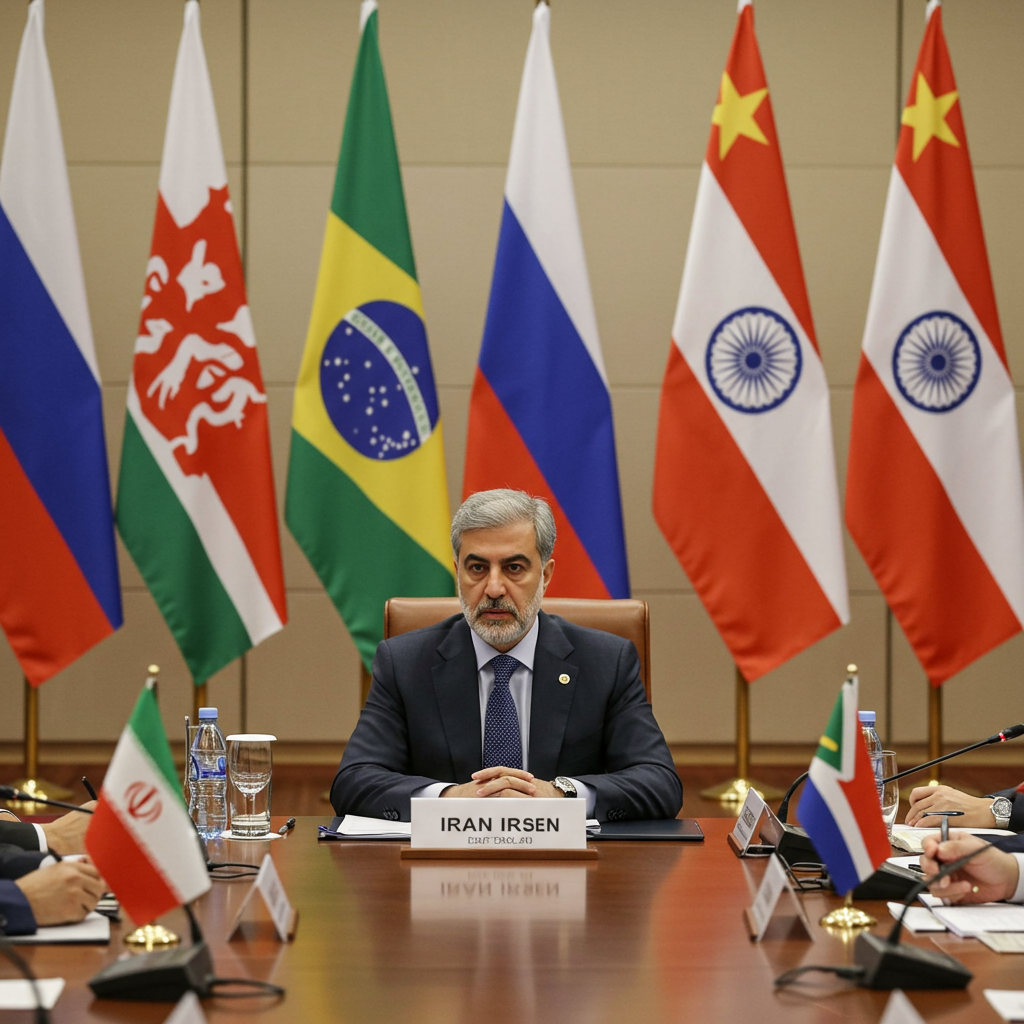Amidst escalating geopolitical tensions, nations are increasingly seeking alliances outside traditional Western blocs. The brics group, an association of emerging economies, has rapidly expanded, positioning itself as a potential counterweight to the established global order. A recent development has placed this ambition under scrutiny: Iran, facing significant isolation and conflict, has formally joined the BRICS ranks, looking for powerful friends on the world stage.
This strategic move by Tehran comes at a critical time. Battered by the effects of conflict and facing international sanctions, Iran finds itself largely alone in its immediate region. Joining BRICS offers a potential lifeline – a platform to showcase powerful connections and seek support from major global players, even amidst threats of further military action over its nuclear program. But can BRICS truly offer the steadfast backing Iran seeks, or does its own internal diversity limit its capacity as a unified front?
What is BRICS and Why is it Growing?
Originally comprising Brazil, Russia, India, China, and South Africa, BRICS formed to give a stronger voice to major emerging economies. Its core ambition has always been to challenge the prevailing Western-dominated global economic and political governance structures. The group has established institutions like the New Development Bank (NDB) and the Contingent Reserve Arrangement (CRA) to offer alternative financing options and promote economic cooperation outside Western systems.
The alliance recently underwent a significant expansion, welcoming Egypt, Ethiopia, Iran, and the United Arab Emirates, and with Saudi Arabia and Indonesia also joining or invited, bringing total full members to ten. This expansion dramatically increases the bloc’s global footprint, now representing roughly 45% of the world’s population and a substantial portion of global GDP. For many joining nations, BRICS is seen as a crucial platform to diversify partnerships, gain greater influence in global forums, and respond to the perceived challenges of U.S. dominance and economic statecraft like sanctions.
Diverse Motivations Drive Expansion
Member states don’t all share the same specific goals. Some, like Russia and China, actively seek to position BRICS as a clear rival bloc to the U.S.-led West, promoting a post-American world order. Russia, in particular, uses BRICS to defy Western isolation efforts stemming from the Ukraine conflict and find partners for trade, finance, and even military-related goods, promoting alternatives to systems like SWIFT. China views BRICS as a strategic avenue to reform the international order and hedge against Western decoupling.
However, other members like Brazil, India, and many newcomers are more focused on multipolarity and reformist goals. They aim to gain leverage, seek equitable power distribution, and access alternative financing without political conditions, often while still maintaining positive relations with the West. India, for instance, balances its historical ties with Russia with strengthening connections with the U.S., using BRICS primarily for multipolarity and Global South leadership rather than purely anti-Western aims. This inherent diversity creates both strength through broader representation and potential friction points.
Iran’s Strategic Turn to BRICS
For Iran, joining BRICS is a clear move to break out of diplomatic isolation. Facing intense pressure, including sanctions and military threats, Tehran desperately needs allies. The BRICS group offers a potential counterbalance to Western influence and a platform to build stronger economic and political ties with major non-Western powers.
Analysts believe Iran intends to use its BRICS membership to secure more explicit support from the group. The hope is that being part of such a large and influential bloc will deter potential aggression and provide economic avenues that bypass Western restrictions. BRICS engagement could potentially facilitate trade and investment, particularly with members like China and India who are significant energy consumers.
Seeking Refuge from Sanctions
A key shared motivation among several BRICS members, including Russia and Iran, is finding ways to mitigate the impact of Western sanctions. BRICS is actively exploring alternative payment systems and promoting the use of national currencies for bilateral trade to reduce dependence on the U.S. dollar and Western financial infrastructure. For Iran, access to such alternative mechanisms could be vital for its economic survival and ability to conduct international transactions. This shared vulnerability to Western economic pressure provides a strong incentive for cooperation among certain BRICS members.
BRICS Unity Tested by Conflict
While the alliance aspires to be a powerful counterweight, recent events have tested its unity. Following military strikes on Iran last month (referencing events prior to the July 2025 original article date), the BRICS group issued a statement expressing “grave concern.” They called the attacks a breach of international law and the United Nations Charter.
However, the statement notably stopped short of outright condemning Israel or the United States. This measured response highlights the significant internal divisions within the bloc. Experts point out that there is “no alignment whatsoever on Iran” among BRICS members. Nations like Brazil and India have complex relationships with both the U.S. and countries in the Middle East, making them reluctant to take a strong stance that could jeopardize those ties.
Balancing Ambition and Reality
This cautious approach in the face of direct conflict involving a new member reveals the challenge BRICS faces in acting as a truly unified geopolitical force. While Russia and China might push for a more confrontational stance against the West, other members prioritize economic stability and maintaining diplomatic flexibility. The alliance’s ambition to rebalance global power dynamics by offering a solid counterweight to the West is constrained by the varied interests and geopolitical calculations of its diverse membership. The response to the strikes on Iran underscored that BRICS is more of a platform for managing shared interests and hedging than a monolithic anti-Western bloc.
The Push for a New Global Order
Despite internal differences, a common thread unites BRICS members: the desire to shift the global balance of power away from U.S. unipolarity towards a more multipolar or egalitarian system. They are united in wanting reforms to global governance institutions, such as the IMF and World Bank, to increase representation and fairness for the Global South.
Economically, the focus is on increasing trade and investment among members, expanding the use of national currencies, and developing alternative financial infrastructure. While a common BRICS currency remains a distant and debated prospect, efforts towards de-dollarization and establishing independent payment systems are underway. These initiatives aim to insulate member economies from potential weaponization of the global financial system by Western powers.
Geopolitical trends significantly influence these efforts. Intensifying U.S.-China competition and uncertainty regarding U.S. foreign policy drive many countries, even traditional U.S. partners, towards BRICS as a hedging strategy. Diversifying partnerships and reducing dependence on the West becomes crucial in a turbulent world.
Internal Challenges and Future Trajectory
Despite its growing size and stated ambitions, BRICS faces significant internal challenges. Beyond the differing views on the West, there are notable tensions between key members like China and India, stemming from border disputes and regional rivalries. Even newer members like Egypt and Ethiopia have historical disputes, as do Iran and Saudi Arabia, despite recent diplomatic normalization efforts.
These divisions mean that while BRICS can provide a valuable platform for dialogue, economic cooperation, and expressing shared grievances against the established order, its ability to act decisively or present a fully unified front on complex geopolitical issues, like military conflicts involving its members, remains limited. The future trajectory of BRICS and its actual impact on world order will heavily depend on whether its diverse members can find consensus and manage internal tensions effectively. For now, Iran’s quest for staunch allies within the bloc highlights both the potential and the current limitations of this evolving global alliance.
Frequently Asked Questions
What are the main goals of the BRICS group in the current world order?
The primary goals of BRICS members are to challenge the perceived dominance of the Western-led global order, particularly in economic and financial spheres. They aim to create a more multipolar world, reform international governance institutions for greater representation of the Global South, promote trade in national currencies to reduce reliance on the U.S. dollar, and provide alternative development financing through bodies like the New Development Bank.
Besides Iran, which other countries recently joined the BRICS alliance?
In a significant expansion, the BRICS alliance recently welcomed Egypt, Ethiopia, and the United Arab Emirates as full members. Saudi Arabia and Indonesia were also invited to join or have expressed interest in membership, further broadening the geographical and economic scope of the group and adding major energy producers to the ranks.
How has the recent conflict in the Middle East affected unity within BRICS?
Recent military strikes on Iran exposed divisions within BRICS. While the group expressed “grave concern” and called the strikes a breach of international law, they avoided explicitly condemning the United States or Israel. This demonstrates that BRICS members have diverse interests and complex relationships with external powers, limiting their ability to present a fully unified, confrontational stance on sensitive geopolitical issues like military conflicts involving member states.



